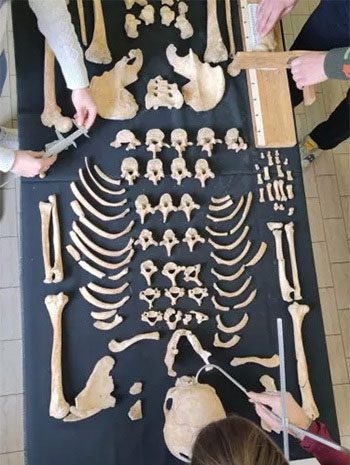Most people around the world have gradually become taller over the past few thousand years, but the height of Milanese citizens has remained unchanged since Roman times.
According to a study published in the journal Scientific Reports on February 23, both male and female citizens of Milan have not experienced any significant changes in height over the past 2,000 years. This is quite unusual, as most other studies on height changes over generations indicate that, on average, humans are getting taller.

LABANOF anthropologists working on archaeological skeletons. (Photo: Lucie Biehler-Gomez).
“This is one of the rare studies where the trend in height over time has not changed in Europe,” said Mirko Mattia, co-author of the study and a postdoctoral researcher at the University of Milan.
“In fact, many studies in Europe have shown a U-shaped trend in adult height. People in Roman times and the Early Middle Ages were relatively tall, followed by a decline during the Late Middle Ages and/or the Modern Age, and finally a recovery in height in the 20th century,” Mattia added.
Height around the world has increased over the past few centuries. Specifically, in the last 150 years, the average height of people in industrialized countries has increased by about 10 cm. Young people today are approximately 5% taller than they were 100 years ago.
The research team found that the height of Milanese men ranges from 152 cm to 195.4 cm, with an average height of 168.5 cm, while the height of women falls between 143.5 cm and 177.6 cm, with an average height of 157.8 cm. Both of these average heights have not changed significantly over time.
The research team used historical data sources and ancient skeletons to measure the average height of Milanese citizens over time. “Skeletons are evidence from the past, which can reveal much about a person’s life. Here, we examine the trend of height changes in Milan,” Mattia said.
Experts examined 549 skeletons, selecting over 50 females and 50 males from each historical period, including the Roman period (1st – 5th centuries), Early Middle Ages (6th – 10th centuries), Late Middle Ages (11th – 15th centuries), Modern period (16th – 18th centuries), and Contemporary period (19th – 21st centuries).
All samples originated from urban environments, specifically cemeteries in the city of Milan, and from similar socioeconomic backgrounds, primarily from the lower class. This was to minimize geographical and social differences. The skeletons were taken from the LABANOF Anthropological Collection (Anthropology and Dentistry Laboratory at the University of Milan), displayed at the Museum of Anthropology, Medicine, and Forensic Science on Human Rights.
The research team suggested several reasons why the height of Milanese citizens has remained relatively unchanged from Roman times to the present. Firstly, the geographical and socioeconomic conditions are uniform, with individuals coming from a single location (the city of Milan) and having similar socioeconomic backgrounds, limiting the impact of geographical and socioeconomic differences,” explained Mattia.
Another possible reason is that living conditions in Milan have been relatively better compared to other regions. The city is rich in natural resources and food, with walls surrounding it that protect against threats.




















































